Celestron NexStar 8SE Telescope Review

The Celestron NexStar 8SE computerized telescope is one of the best-selling telescope packages of all time. It features a large aperture optical telescope and a computerized GoTo mount.
The NexStar series of SCTs has been around for over a decade, and I was finally able to experience this beginner-friendly telescope for myself.
I was impressed with the completeness of this package, from the 1.25″ 25mm eyepiece and diagonal to the red dot finder mounted to the 8-inch OTA.
Key Takeaways
- The NexStar 8SE is the largest model in the NexStar series, with an 8″ aperture telescope capable of crisp, high-magnification views.
- This telescope excels at viewing the planets and the moon in detail, thanks to its large aperture and built-in computer system that can find and track objects.
- While the optical tube itself is fantastic, the fork mount base of the NexStar 8SE can be a little wobbly, considering the weight and cost of the system.
Celestron NexStar 8SE Video Review.
Overview
This is a primarily visual telescope meant for enjoying views of the moon, planets, and the brighter nebulae and galaxies through the eyepiece.
But what about astrophotography? The design of the tracking telescope mount (fork-mounted Alt-Az) wasn’t designed for it, but is it a complete waste of time?
Absolutely not, but you’ll need the right approach for the best results. In this post, I’ll show my results using Celestron’s NexYZ smartphone adapter.
If you’re in the market for a grab-and-go telescope (that excels in views of the moon and planets), I think you will enjoy my review of the Celestron NexStar 8SE.
Setting up the NexStar 8SE in my backyard for a night of visual astronomy.
Celestron NexStar 8SE Review
Is this the all-in-one telescope package that does it all? Not quite, but that’s okay. It gets the important parts right.
he telescope OTA (optical tube assembly) is top-notch, while the mount is just enough to get you by.
I asked the AstroBackyard community on Facebook how they felt, and almost all of them had amazing things to say about this telescope.
From seeing their first-ever view of the planet Saturn to surprisingly impressive astrophotography, the NexStar 8SE is a widely appreciated piece of kit.
Just look at what Ptolemy The Space Nerd has been able to capture using his phone and the Celeston NexStar 6SE (yes, the smaller version of this telescope!)
I use a go-to mount, simple to use. I mainly use it for planetary work but I’ve gotten away with some deep sky! pic.twitter.com/VIFudlyvr0
— Ptolemy The Space Nerd (@Astro_Ptolemy) November 4, 2023
Incredible images of the Moon, Sun, and even the Orion Nebula by Ptolemy The Space Nerd on Twitter.
There are a few quirks of course (the red dot finder scope is rudimentary, and the single-arm fork mount is a little shaky), but overall everyone seemed to agree that it was a smart purchase and they got a lot of use out of it.
Some people even mentioned that had sold the scope, and wished that they had kept it.
As an astrophotographer, the first thing I noticed was the Alt-Az fork mount, and that’s not what you want if your primary interest is long-exposure astrophotography. (An equatorial telescope mount is best).
But, people have taken impressive images with this telescope, it just requires a different approach. If you’re into photographing planets the Celestron NexStar 8SE will work out just fine.
This 8″ SCT was meant for crisp views of solar system objects, and that is where it excels.
If you look at the specifications for this telescope, it highlights some pretty impressive potential for a variety of visual observations.
I can see why beginners are drawn to this package as their first serious scope.
The NexStar 8SE is great for spur-of-the-moment observing sessions of the moon or planets.
NexStar 8SE Telescope Specifications
- Aperture: 203 mm (8″)
- Telescope Focal Length: 2032 mm
- Focal Ratio: F/10
- Camera/Eyepiece Connection: 1.25″ Nosepiece
- Diagonal Included: Yes
- Tripod Weight: 10 lbs
- Tube Weight: 12.5 lbs
- Computerized: Yes
- Drive Type: DC Servo motors
- Optical Design: Schmidt-Cassegrain
- Secondary Obstruction: 35mm
- Tube Diameter: 226mm
- Tube Length: 432mm
Included Items
- 8-inch Schmidt-Cassegrain OTA
- NexStar SE Mount: Motorized Alt-Azimuth/ GoTo
- Tripod with Adjustable Steel Legs
- Red Dot Finderscope
- Accessory Tray
- NexStar+ Hand Controller
- 1.25-inch Star Diagonal
- 1.25-inch, 25 mm Eyepiece
- Mini-USB Port
- Celestron Starry Night Software
- 2 Year Warranty
First Impressions
Setting up the Celestron NexStar 8SE for the first time was quick and painless. Once assembled, the kit is light enough to carry around the yard if necessary.
Although the red dot finderscope is simple and inexpensive, it is surprisingly effective at confirming the pointing direction of this high-magnification telescope.
Powering the NexStar 8SE
I used an AC adapter to plug the mount into household power in the backyard, but it can also be powered by 8 x AA batteries for complete mobility.
I recommend picking up a portable 12-volt DC power supply to run the telescope for an entire night, especially if you do astrophotography.
Celestron makes a portable PowerTank (shown below) for this purpose, but you might want to consider a more powerful portable battery station for extended use.
Powering the NexStar 8SE using Celestron’s 12V PowerTank.
Tripod
Right out of the gate, I noticed a few things. The tripod, which I would call “medium-duty,” is similar to the one in the newest Sky-Watcher Star Adventurer GTI package.
It seems stable enough for a mount and scope of this size and keeps weight down for travel.
The trade-off of a heavier, more stable tripod probably isn’t worth the extra weight. The mount head connects securely using three threaded bolts. It has a nice design, and it feels secure.
Single Arm Fork Mount
The mount head unit and fork arm have a plastic outer casing, reminding you that this is a budget-friendly GoTo telescope package.
The Celestron NexStar remote seats neatly inside the arm, which is a clever space-saving design.
Users of this Celestron NexStar 8SE mentioned that a dual-arm fork design (like the one on the CPC series telescopes) would help the OTA feel a lot more secure.
The motorized mount head is where the cost savings come into play. It feels a little “toy-ish”, but the 8″ NexStar OTA reminds us that this is a serious telescope.
The mount on the NexStar 8SE has a Vixen saddle, which is a common telescope mounting style.
However, I do not recommend mounting any other telescope on the NexStar 8SE base due to its weight limitations and shallow profile.
Schmidt-Cassegrain Telescope
It’s an 8-inch Schmidt Cassegrain telescope with a focal length of 2032mm at F/10. The orange tube Celestron SCT has been in production since 1970 and for good reason.
It packs plenty of light-gathering power into a compact, practical size.
The optics on this telescope deliver crisp, high-contrast views, thanks in part to Celestron’s Starbright XLT optical coatings.
This telescope collects light at an f-ratio of F10, which is much “slower” than a typical reflector or refractor telescope.
This means that the fainter nebulae and galaxies will be tough to observe, especially if you’re observing the night sky from a light-polluted city.
Collimation and Image Shift
Schmidt-Cassegrain telescopes require collimation from time to time (some say about once a year), and this can be a daunting task if the process is new to you.
I wouldn’t advise taking this process on until you are certain that your telescope is suffering from bad collimation. At the time of writing, I have never collimated either of my SCTs, ever.
The telescope does experience image shift (a common occurrence on an SCT), but it is not serious enough to take away from the visual experience.
The 8″ SCT optical tube assembly mounted to the single-arm fork mount.
Attaching an Eyepiece or Camera
On the back of the NexStar 8SE optical tube, you’ll find 2″ threads to attach a star diagonal, focal reducer, and photography accessories such as a T-Adapter for your DSLR or Mirrorless camera.
NexStar Hand Controller
The Celestron NexStar 8SE includes a NexStar hand controller, with over 40,000 objects in its database.
The hand controller fits neatly inside the arm of the fork mount, and can also be extended for use while at the eyepiece. This is a clever design and works well in the field.
25mm Plossl Eyepiece
A 1.25″ 25mm Plossl eyepiece was included with the telescope. This is a useful magnification for a variety of objects in the night sky from planets, to bright galaxies.
It is important to use an eyepiece that does not have a high magnification when aligning the telescope. You may want to purchase an even wider eyepiece (such as a 32mm Plossl) for this purpose.
The higher the magnification of the eyepiece, the more “searching” you will have to do to align the telescope mount to a bright star.
Portability
Even with the large aperture SCT telescope, the entire kit weighs just 24 lbs in total. The mount, telescope, and tripod can be broken down into individual parts for easier transport.
This telescope is much easier to bring with you to a dark sky site than an equivalent aperture Dobsonian telescope.
The fully-assembled setup can easily be lifted up and moved across the yard, or brought back into your house or garage.
For example, the Celestron StarSense Explorer Dob delivers a brighter view at F/5.9, at the cost of a heavier kit to transport (about 42 pounds).
GoTo Computerized Mount
One of the biggest draws to this telescope, aside from the compact, travel-friendly design, is its computerized GoTo functionality.
You can choose an object you would like to view on the hand controller, and the telescope will point right to it.
Of course, to do this, the telescope needs to be where it is on Earth for accurate pointing. Luckily, this is a dead-simple process called “SkyAlign“.
The SkyAlign feature is used on several Celestron mounts including the NexStar GT, NexStar SLT, NexStar SE, NexStar Evolution, SkyProdigy, Astro Fi WiFi, and CPC telescopes.
To align the mount you need to point to (and center) three bright stars in the night sky.
You don’t have to know the location or name of a single star in the sky for it to work. You simply choose your location from the database, I chose Toronto (close enough), and point the scope at three bright stars. Any 3 bright stars.
To help you point directly at them, you can use the included red dot finder. Keep both eyes open, and move the scope until the red dot is directly on the star. When you look in the eyepiece, it should be right there, or very close.
Then center the star, and confirm these 3 positions. Once that is done, your telescope knows exactly where to point.
On my first night out with the Celestron NexStar 8SE, I chose to observe the Ring Nebula in the cancellation Lyra.
Sure enough, with the simple SkyAlign routine performed beforehand, the telescope slowed right to it, first try.
Now that is a positive first experience. Bravo Celestron.
How Stable is the NexStar 8SE Mount?
One of the Celestron NexStar 8SE’s shortcomings is that many people feel that the telescope is ‘under-mounted’.
This simply means that the telescope is a little too heavy for the tracking mount that is supplied with it, and I would have to agree with this.
The 8-inch model in the NexStar series uses the same Alt-Az fork mount as the smaller NexStar 6SE.
Thankfully, it is up to the job of slewing the large 8-inch optical tube around the sky, but it does seem a bit wobbly for the price of this package.
This wobble can be reduced using Celestron’s vibration suppression pads (sold separately) but will still be present when the tripod legs are fully extended.
The 8″ Schmidt-Cassegrain telescope in the NexStar 8SE package can be attached to other equatorial mounts (Sky-Watcher Wave 150i shown).
Recommended Accessories
To really enjoy using this high-magnification telescope, do yourself a favor and pick up a nice wide-field eyepiece.
As mentioned, the NexStar 8SE package includes a 1.25″ 25mm Plossl, which is a decent start.
A wider eyepiece will make the star alignment process easier and make for a brighter view.
I tested an old Celestron 32mm Plossl eyepiece on the 8SE, providing a slightly wider, brighter view through the telescope.
A wider (lower magnification) eyepiece will make the SkyAlgin process easier because the alignment star will be easier to locate in a larger area of the sky.
If you are looking for a suggestion, I recommend the Tele Vue 32mm Plossl Eyepiece.
If you’re after planets, get a decent high-magnification eyepiece, too, something in the 10mm or lower range.
Remember that the view through a high magnification eyepiece under 10mm will be much dimmer.
The Celestron Luminos 10mm eyepiece is great for viewing planets up close.
If you live somewhere with a lot of moisture in the air (like I do), you should consider purchasing a dew shield.
I use the one with a Velcro strip that wraps around the telescope’s objective lens (shown below). This prevents frost and moisture from accumulating on the telescope’s lens.
I use a dew shield to keep frost and moisture off the telescope.
Celestron NexYZ Smartphone Adapter
Yes, you can do astrophotography with the Celestron NexStar 8SE! The simplest way to get started is to use your existing smartphone and hold it up to the telescope’s eyepiece.
Using this method (eyepiece projection astrophotography), you can capture impressive images of the Moon, Jupiter, Saturn, and Mars.
The NexYZ adapter holds your phone up to the telescope eyepiece, with controls to get your phone camera lined up perfectly.
The tricky part is keeping the phone still enough for a photo and lining the camera lens up with the center of the eyepiece.
Thankfully, the Celestron NexYZ smartphone adapter can help with these tasks, thanks to a clever 3-axis design.
The adapter clamps onto the objective of the eyepiece (both 1.25″ and 2″ eyepieces) and securely holds your phone in place.
The Celestron NeXYZ Smartphone Adapter.
You can use the 3-axis adjustment knobs to center your smartphone’s camera lens in the eyepiece. Using your camera’s “pro” or “manual” mode, you can fine-tune the camera settings to take an amazing photo of the Moon’s surface or Saturn’s rings.
Smartphone astrophotography with the Celestron NexYZ adapter is best for pictures of the moon and bright planets.
Deep-sky astrophotography (of galaxies and nebulae) will require additional hardware, such as the Celestron NexStar SE & Evolution Wedge , and the proper adapter and T-ring for your DSLR.
Related Post: How to Attach a Camera to Your Telescope
I included the Celestron NexStar 8SE on my list of best astrophotography telescopes because it is a great way to get started in moon photography. Its OTA is worthy of being re-mounted to an EQ mount in the future.
Best Objects to See in the NexStar 8SE
The Celestron NexStar 8SE is best used for high-magnification views of the Moon and planets.
Using the included 25mm Plossl eyepiece, the views of Saturn and Jupiter are incredible.
The SkyAlign feature allows you to get up and running quickly, so you can start observing sooner.
Here are some examples of objects you can enjoy seeing through the Celestron NexStar 8SE, even from your backyard:
- The Moon
- Saturn
- Mars
- Jupiter
- Venus
- Ring Nebula
- Dumbbell Nebula
- Pleiades
- Andromeda Galaxy
- M13 Globular Cluster
Is the NexStar 8SE Worth it?
While your overall satisfaction with this telescope depends on what you want to use it for most, the NexStar 8SE is absolutely worth the money.
You get an 8-inch Schmidt-Cassegrain Telescope with excellent optics and a computerized mount that can point to objects in the night sky for you.
Building a telescope package like this for the price would be nearly impossible when buying the items separately.
The included eyepiece and red dot finder are useful accessories that allow you to start using the telescope right away.
The weakest aspect of this package is its single-arm fork-mount design, but it still does an admirable job moving the telescope around the sky.
Is the Celestron NexStar 8SE Good for Beginners?
This is a great telescope package for beginners because it includes everything you need to start observing the night sky.
Many telescopes that are sold with a mount do not include computerized “GoTo” functionality.
While I believe that a manual Dobsonian telescope is the ultimate choice for beginners, I understand that many people need help finding objects.
The telescope’s aperture is large enough to pull in enough starlight to reveal the planets in detail, as well as some of the best deep-sky objects in the night sky.
For many people, the NexStar 8SE provided them with their first-ever look at the planet Saturn, and the Orion Nebula.
Final Thoughts
I have a soft spot for equipment that makes the astronomy experience welcoming and approachable.
Too many beginners have had a frustrating experience on their first night under the stars, and many of them do not return to the hobby.
The NexStar 8SE can deliver you your first view of the planet Jupiter, or the Andromeda Galaxy.
Getting to this point is straightforward and rewarding, and does not require existing comprehension of the night sky.
The single-arm fork-mount design isn’t perfect, and it sacrifices stability for a compact, portable design.
In a nutshell, the telescope and optics are fantastic, the mount is not.
When slewing the telescope at slower speeds (4 or below), I noticed that the response is “laggy”, meaning that the telescope does not move for a second or two after pressing the arrow button.
Be advised that touching the telescope or eyepiece while viewing an object will result in a shaky image, so keep those hands off while observing. This is something you will need to get used to.
The NeXYZ smartphone adapter is a great little design, probably the best one on the market. But capturing anything other than the moon or planets will be challenging.
Others have done it, but unless you’re willing to put the time in using a phone for deep-sky, stick to solar system objects.
You can fasten a DSLR camera or planetary camera to the telescope for much better images, but to accurately track objects you will need to invest in a wedge to orient the telescope towards the celestial pole.
The NexStar SkyAlign system is dead simple to perform, and you can skip over the polar alignment process and get straight to observing.
The telescope can find and follow an object in the night sky for you.
Saturn stayed in the center of the eyepiece for almost 20 minutes at over 2000mm focal length – try to do that with a manual dob.
The 8″ telescope has enough aperture to deliver amazing views of the moon, planets, and brighter nebulae and galaxies.
If the price of the 8SE is too steep for you, you have options. This telescope comes in 4, 5, and 6-inch versions.
The NexStar series of computerized Schmidt-Cassegrain Telescopes.
Overall, the Celestron NexStar 8SE is a remarkable product. I highly recommend it to anyone looking for a practical, travel-friendly visual scope that lets you get your feet wet in astrophotography.
Where to Buy:
Alternative Options
If you are willing to give up the GoTo functionality and portability of this computerized telescope, you can purchase a Dobsonian telescope with more light-gathering power than the NexStar 8SE.
For example, you could get a Celestron StarSense Explorer 12″ Dobsonian for roughly the same price. Although this telescope is completely manual, you now have 12 inches of aperture at F/4.9.
The Celestron StarSense Explorer 12″ Dob.
Keep in mind that this telescope does not have tracking like the NexStar 8SE has, so you will have to manually follow objects by slowly pushing the telescope.
You can read my full Celestron StarSense Explorer Dob Review to learn more about this innovative package.
As always, I was not compensated in any way for providing a positive review of this product. Nor does Celestron have any say in my written or video content.
Trevor Jones is a deep-sky astrophotographer and a valued member of the RASC. His passion is inspiring others to start their astrophotography journey on his YouTube Channel so they can appreciate the night sky as much as he does. His images have been featured in astronomy books & online publications, including the NASA Astronomy Picture of the Day (APOD).
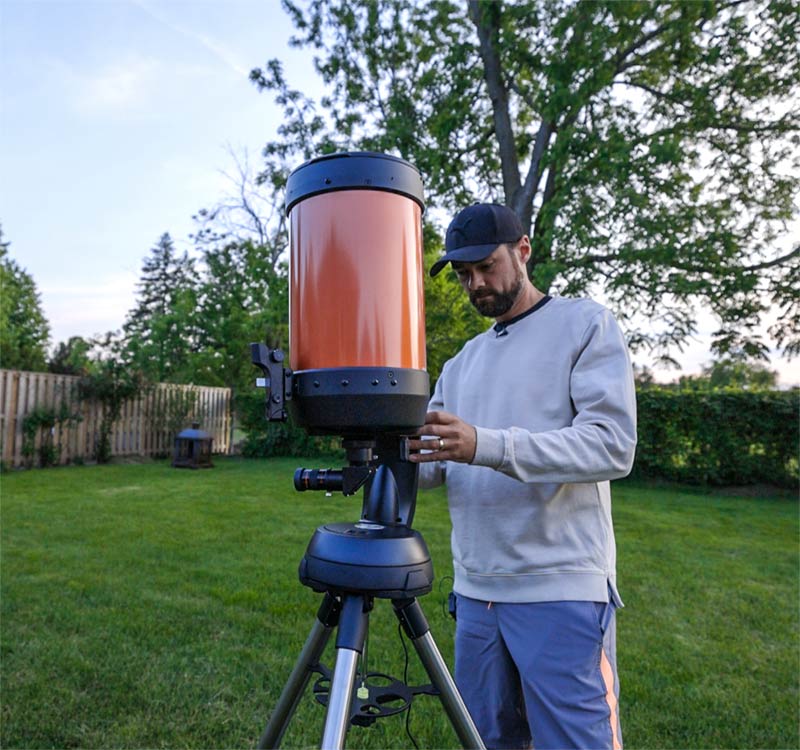


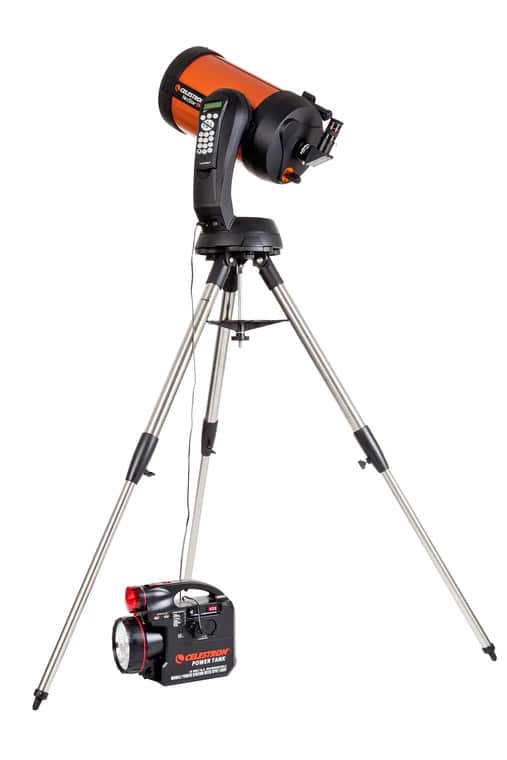

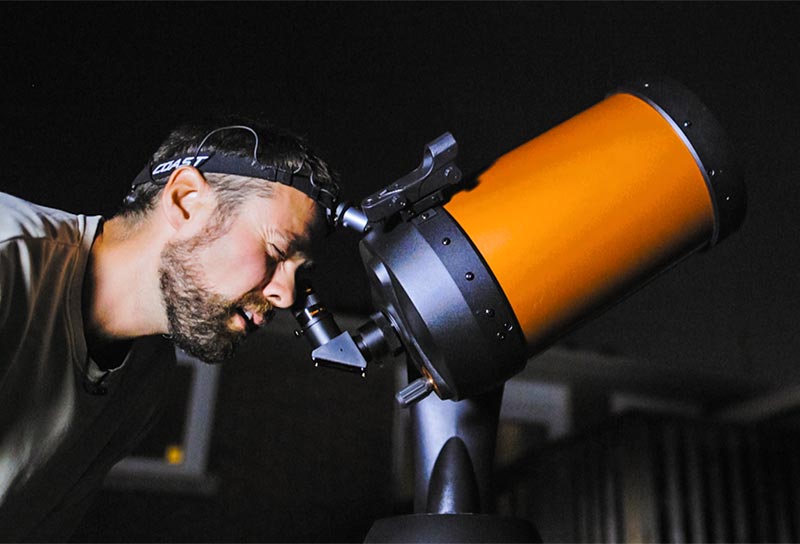




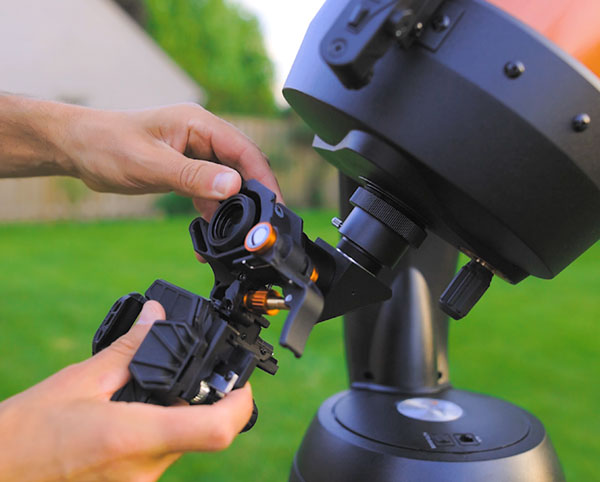


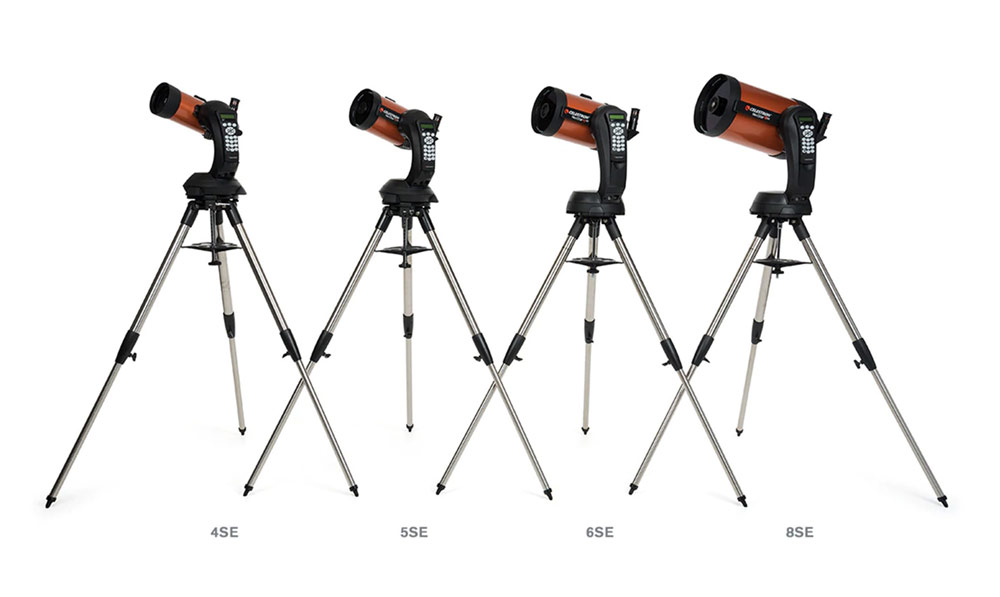


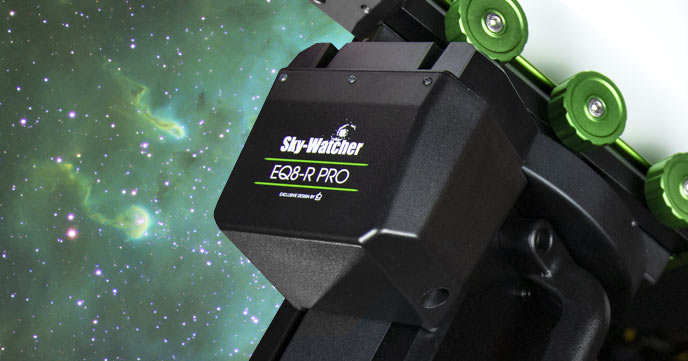

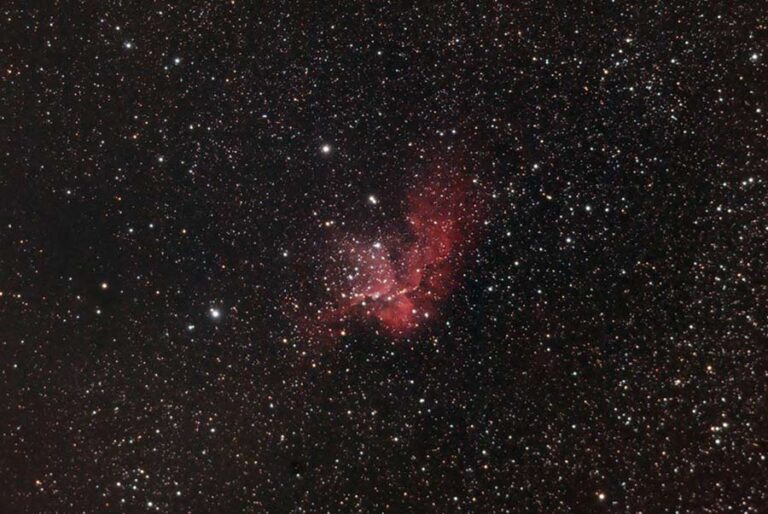


Hello You manage to get big images from small refractors, how is that possible? Thank you Frank
Frank, we are getting started, but I would like to be able to view more objects well than just a few planets, Andromeda, etc. Can you recommend a telescope with good apertrure, optics, nad mount that has computerized tracking, please. We will be looking for a second-hand one. Thanks!
I have viewed tons of objects with this scope in Bortle 7 skies. In darker skies, views are even more impressive. Don’t get rid of this scope. You’ll have plenty of things you can view with it. I promise. I have viewed galaxies, planetary nebula, other bright nebulae, open clusters, globular clusters, and galaxies. It’s a very capable scope for visual astronomy.
Can the Celestron 8SE be accurately aligned (3 star alignment) with the focal reducer attached?
Thank you.
Yes! In fact, the process will be a little easier due to brighter stars and a wider field 🙂
I might have a lemon. I purchased the 8se & some eyepieces (10mm, 35mm, & 6.3 focal reducer).. my images are not worth the money ($1.350). My image of Jupiter is like a ½ inch like circle with some vague colors & lines, with 4 specks as its moons. My Saturn is a tiny little frog’s pupil shaped thing. Mars & s no better through the scope as it is just looking up into the sky. I’ve researched this telescope & images online sre nothing like mine. WHAT AM I DOING WRONG?!?
Hi Sal – the images/views you are seeing are very normal when starting out! If you have got this far, you are on the right track. I think the best thing to try now would be to use a 2X barlow lens – this will increase the size of the planets by 2, and I think you will find that this alone will make a big difference. You can try it with the 10mm eyepiece for a great look at Jupiter this fall.
I think it is very disappointing that a “astrophotographer” reviews a visual astronomy telescope! The fact that its a Az/alt mount is an advantage because it makes for much more comfortable viewing, your eyepiece only moves up and down between objects, so if you have a height adjustable chair you can view the whole night long! This type op scope is the ultimate visual package: easy and fast to align, no polar alignment, light weight for a 8″ so easy to transport.
That is a great point. It’s hard for me to look at telescopes from a strictly visual perspective these days. You are spot on with this one.
I’m interested in purchasing this telescope because a friend, and advanced amateur astronomer, told me he uses his NexStar 8SE to shoot astrophotography images with his Nikon D850 DLSR Camera. Some of his photos are fantastic. I’m a pro photographer who happens to shoot with the D850 pro camera. And I’m interested in doing some astrophotography work. I know that a T-mount and a T-adapter are available for attaching the 8SE to the camera. I was wondering if anyone had any experience with using the 8SE for astrophotography purchases and if they are satisfied with the imaging achieved.